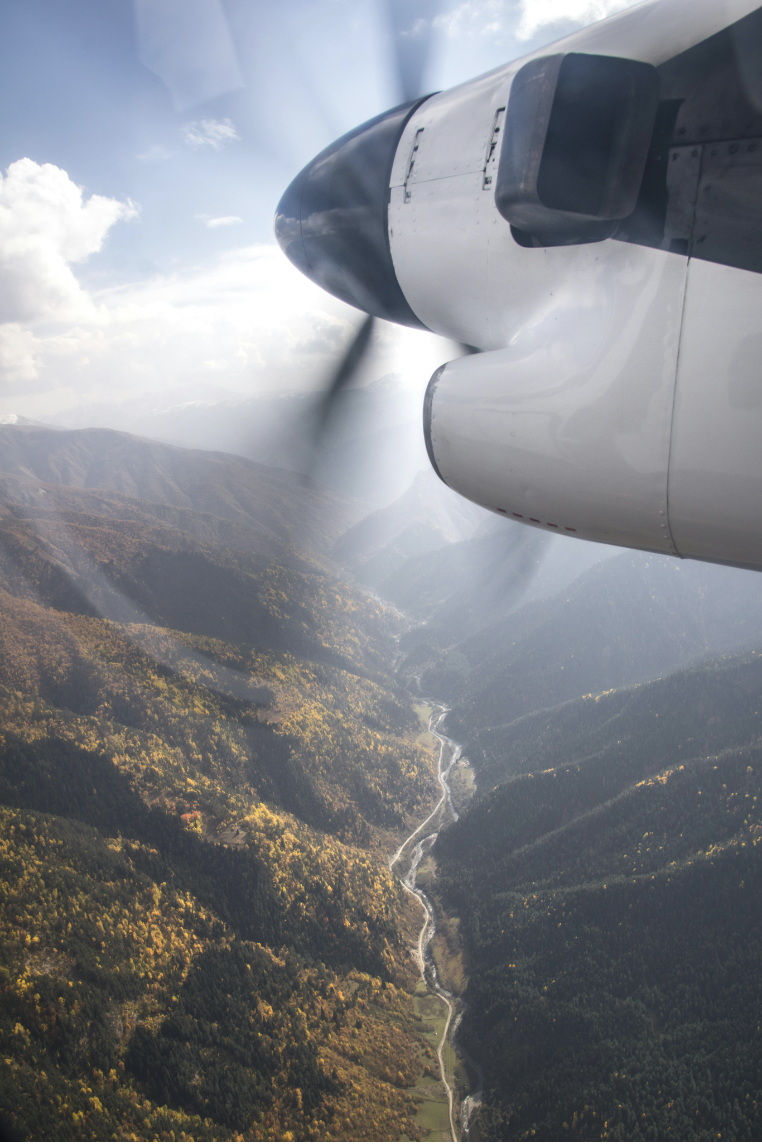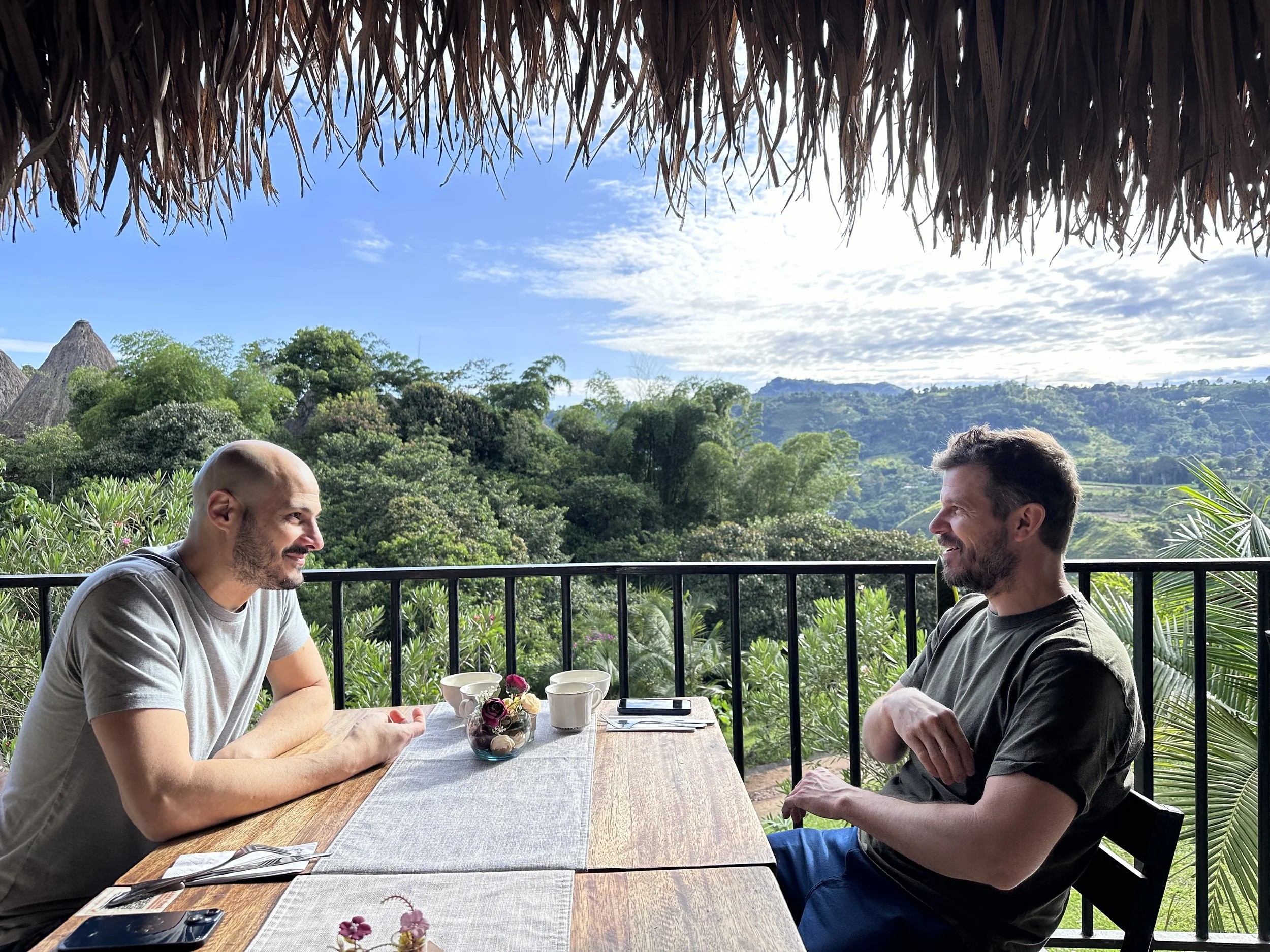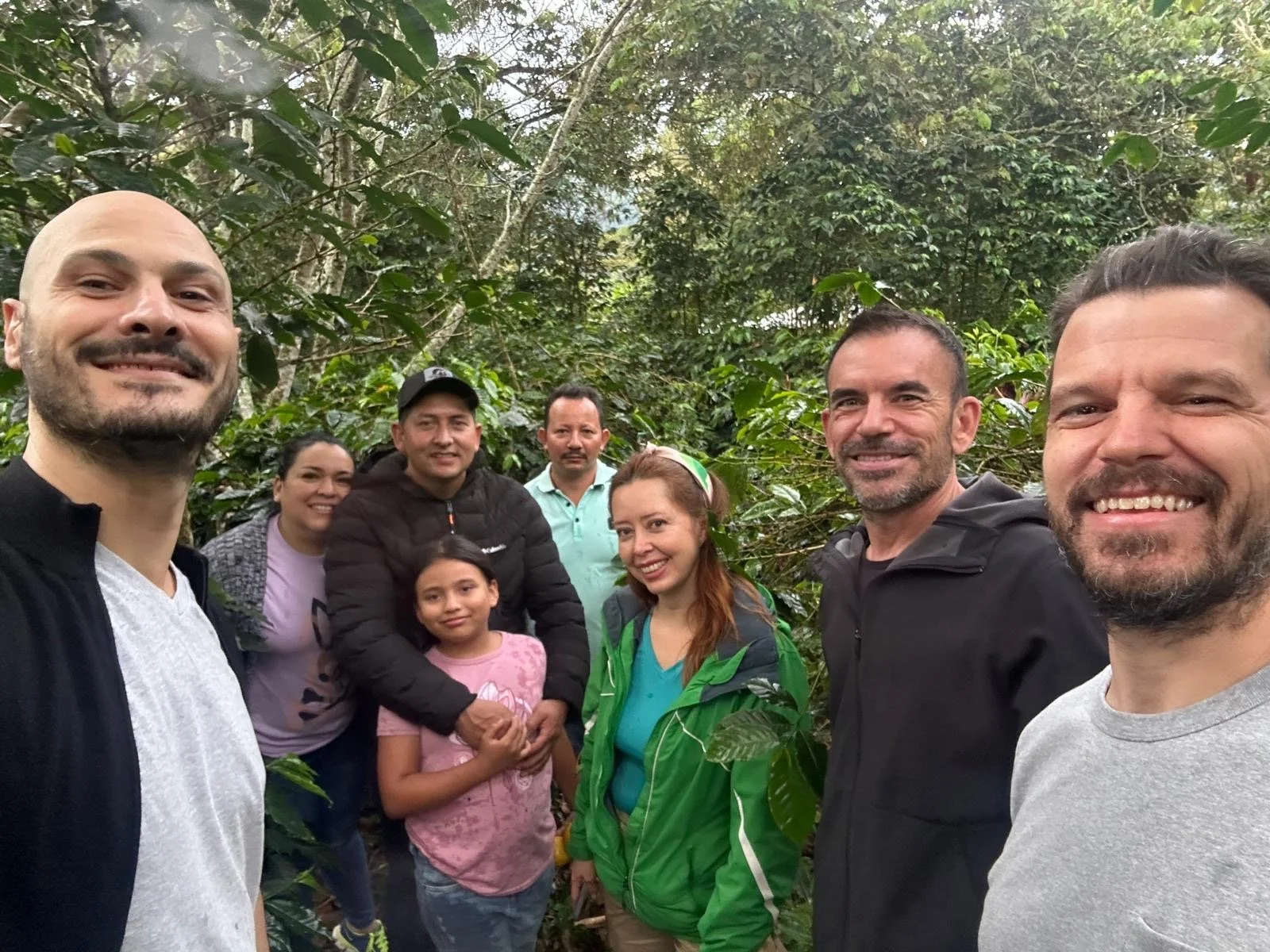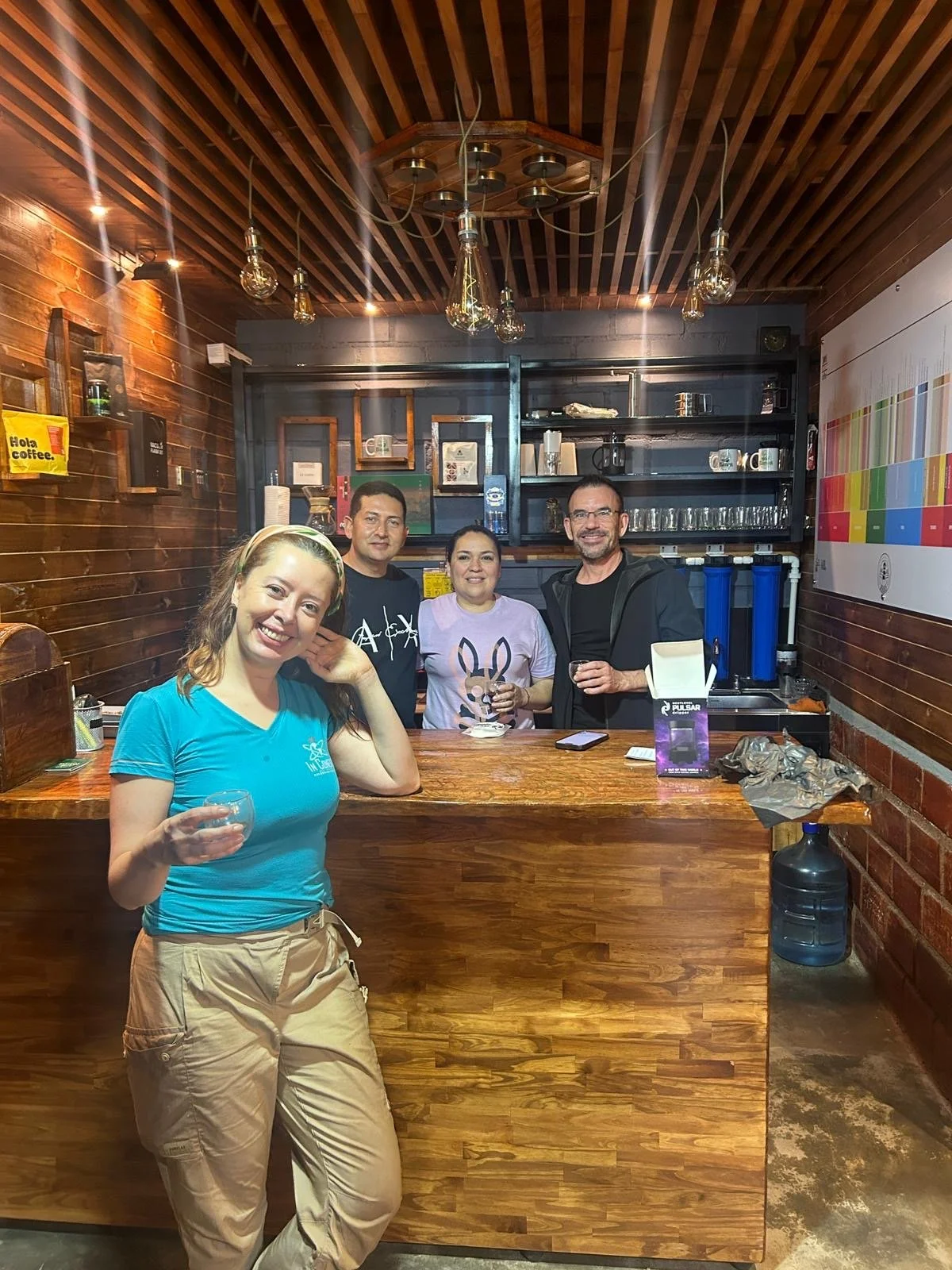Viva Colombia
I recently spent twelve days in Colombia. It was an unforgettable trip, full of learning, beautiful scenery, wonderful hospitality and new friends. I’d like to share a bit of my experience with you.
I visited Colombia at the urging of Diego Bermudez. Diego and became friends after having dinner together in San Francisco and Chicago, and we plan to work together on some future projects. After his numerous invitations to come to Colombia, I found time in May. Since I was visiting Colombia, I made plans to meet several farmers, mills, and exporters we work with at Prodigal.
Medellin
My first stop was Medellin, a dramatic, mountainous city of five million people. While in Medellin, I had the pleasure of visiting Nikolai and Manuela at their apartment and their mill/lab/roastery located on a coffee farm on the city fringe. After a delicious vegan breakfast, we visited the mill and lab, which are a five-minute walk from their apartment. Nikolai mills coffee in Medellin for several of Colombia’s best producers, including the famous Wilder Lazo. Nikolai and I had several cupping sessions, worked on sample-roast profiles on his Roest, and talked about ways to hack his Diedrich IR-12. We toured their small mill as well as the farm’s nursery. Nikolai’s operation is small, but laser focused on top-quality coffees.
On day two I visited Stephen at The Coffee Quest mill near the Medellin airport. The mill is fantastically clean and efficient. We cupped two dozen coffees, talked about their QC protocols, sample roasting, buying stations, and their systems for labelling and tracking coffees through the milling process. If you’ve tasted Prodigal’s Perlitas, Pradera, Finca Costa Rica, or Las Jazmines, they came from Coffee Quest. If I had to sum up Coffee Quest in a few words, they would be: efficient, systematic, and excellent value.
Cauca
On day three, I flew to the small airport at Cali to meet Diego and Matheus. Our first stop was Finca Betel, to meet Diego’s cousin César and his family. Mark and I already loved César for his exceptional coffees, his infinite friendliness, and his sunny outlook on life, so I was eager to meet César in person. Upon arrival at the farm, we were greeted by César, his friends, and his parents. I was urged to sit, and a plate of food immediately appeared. We spent hours in rapt conversation about life and coffee, we shared several cups of César’s clean, delicate, lactic-fermented natural Laurina, toured the farm and processing areas, and cupped several coffees. I felt like part of the family. The scenery at Betel is gorgeous: the farm is perched on a hillside overlooking Calima Lake. The covered, open-air living room of the house fostered vibrant conversation with expansive views. César has often told me he lives in paradise, and I agree.
After dinner, Matheus informed me we would spend the night at Betel. I was a little concerned, because Diego and Matheus had told me several times that protestors and guerrilla activity in Cauca often shut down all of the area roads. Given that the roads were currently open, it seemed prudent to drive to Diego’s farm that day. Sure enough, we woke up at Betel to the news that there were several protests and road closures in the area, we couldn’t go to Finca El Paraiso, and Diego could not go home. The protests grew quite extensive, so later that day we abandoned our plans to visit Paraiso. Our consolation prize was a blissful day at Betel, more touring, learning, and wonderful conversation, and finally a visit to the cafe César and Diego co-own in the town of Florida. The cafe was gorgeous, with a Stronghold roaster and a modern third-wave coffee bar, as well as waffles made from the local favorite “pan de bono,” which, happily, is gluten free. I had my first waffle in 20 years before heading to the airport to return to Medellin.
Clockwise: César with our coffees; Diego making our morning coffee; me with Matheus, Diego; cupping with legends; César explaining his drying oven; the view from above Finca Betel.
Medellin
I returned to Medellin for a few days and had some relaxed visits with Nikolai and Stephen as well as some new Colombian friends. I was disappointed to miss Finca El Paraiso, but enjoyed having a couple of free days in Medellin.
San Agustin
Next I flew to Pitalito with a stopover in Bogota, with a plan to meet Andrew and Wilson from Suited NYC in Pitalito. They would join me for the second half of the trip. Bogota airport was a little confusing, as it wasn’t clear which terminal I needed to fly from, or even which airline to check in with, as my flight was with Clic Air, a subsidiary of Avianca. The confusion cost me some time, and I decided to take a taxi between the terminals to save a few minutes. While in the taxi, I saw Andrew and Wilson on the sidewalk, also seemingly confused about where to go. I asked the taxi to stop, I yelled their names, and they hopped in the cab. I took the chance meeting as a sign of good fortune.
<< caption: Andrew and Wilson at Masaya
When we arrived in Pitalito, we were met by Adriana, co-founder of Inconexus. We stopped at an Argentinian steakhouse for lunch, and some musicians dropped in to play during the meal. After lunch we drove two hours down a dirt road to Finca Las Palmas, a gorgeous farm owned by Efren and Adriana Mora, that Prodigal purchased from in 2023. While rain poured down, we were treated to a tour of the drying patios, guardiola, and the farm’s coffee bar, where Efren roasted and brewed us a cup of his alcoholic-fermentation natural. We were blown away by the quality of green, the roasting, and the brewing, and i got a kick out of watching Andrew drink the coffee, his first in Colombia. I could tell he was wondering “does everyone in Colombia roast coffee so well?” Unfortunately not, but I experienced several impressive, delicate roasts at Las Palmas, Betel, and Nikolai’s lab. Most producers and exporters roast rather dark by modern standards, but it was encouraging to find so many people in Colombia roasting light.
The skies cleared as soon as we were ready to tour the farm, as it did every time we needed to go outside. I won’t say we influenced the weather, but a sort of Gabriel-Garcia Marquez magical realism followed us everywhere, whether it was perfectly-timed weather, our sense of time expanding and contracting, or just feeling like we were in a fantasyland. At Las Palmas we tasted our first grenadilla, my new favorite fruit, and guama, a giant pod with seeds encased in a pulp reminiscent of cotton candy. Personally, I loved that so many Colombian fruits had unexpected textures and very mild sweetness. Before we left, I gifted Efren a NextLevel Pulsar, we brewed one together, and we had yet more delicious coffee, alongside some unforgettable arepas fresh from the oven.
From Las Palmas we drove to Masaya, a fabulous accommodation perched on the edge of a canyon in San Agustin. Our hunger made dinner all the more special, and we spent the meal pestering Adriana with questions about Inconexus’ mission and work with farmers, and about coffee trading in Colombia. Bizarrely, the same musicians from lunch in Pitalito showed up to play at Masaya in San Agustin.
The next day, Adriana took us to five coffee farms she works with, beginning at Llanada, where Oscar Omer, a chemist who formerly worked in the yogurt industry, gave us a tour and graciously fielded my many questions about microbes and coffee fermentation. From Llanada we visited El Placer, owned by Pastor Odoñez, and Finca Filadelfia, owned by Ciceron and Alicia Rodriguez, who graciously served us lunch. Prodigal recently purchased some coffee from Filadelfia, and having met the wonderful people behind the coffee makes it even more special to offer it to our customers.
Adriana did a great job of showing us several farms that produced lovely coffee using different approaches. Some farmers were more scientific in their approach to fermentation and drying, others followed more traditional systems, and all proudly showed us their gorgeous farms and shared their life’s work. At the end of our day of farm tours, we stopped at the Inconexus warehouse in San Agustin. We were treated to some nicely roasted coffee (again!), a tour of their operations, and a cupping of about 15 coffees. The cupping generated some lively discussion about sample roasting, scoring, processing, and things we had seen that day. The Inconexus team was gracious and friendly, and I felt great about being their customer.
Clockwise: Enjoying the Finca Las Palmas family; drying patio; guardiola; enjoying a cup at Las Palmas, Pastor Odoñez and Adriana on Pastor’s rooftop drying patio; Adriana sniffing a fermentation barrel at Las Palmas;
San Adolfo
The next morning we said our goodbyes to Adriana and drove to San Adolfo to meet Nikolai and his photographer friend Carlos. After dropping our bags at a (coffee) farmstay owned by Victor, one of the most inspiring, friendly young people I’ve ever met, we drove to Wilder Lazo’s farms. After some hellos, we immediately jumped into the first of several cuppings in his lab. We spent the next two days touring Wilder’s farms, cupping every chance we could get, and discussing sample roasting, color measurement, and approaches to processing. We tasted some lovely coffees, including the uber-light Prodigal roast of his Lot 2 Geisha I had put on the cupping table. The most rewarding moment of the visit was when Wilder praised my roast of his coffee and asked how he could get that kind of flavor from his sample roaster.
Pitalito
We spent one night in Pitalito after leaving San Adolfo. Wilder and his wife Leidy joined us in Pitalito for a lovely sushi dinner, nonstop vibrant conversation, and the next day we cupped at the office of an exporter friend of Nikolai’s. While Pitalito is a modest city, what’s fascinating about it is the amount of coffee traded there. Pitalito is a hub where coffee farmers sell their harvests to middlemen, and it seemed half of the buildings in Pitalito were warehouses for green coffee in various states (cherry, parchment, green).
Such scenes led to many conversations with Andrew and Wilson about the realities of coffee trading, and how they contrast with the online and marketing myths about how coffee gets from farmers to consumers. Marketing materials and politicized online discussions about coffee production rely on over-simplified narratives. The reality is complicated, heterogeneous, and messy. Many blog posts on the subject will follow, I’m sure. Spoiler alert: choosing relatively pricey, specialty coffee is the only sustainable path for the industry.
Bogota
From Pitalito, Nikolai, Carlos, Andrew, Wilson, and I flew to Bogota for dinner al fresco at a delicious Italian restaurant. While I like rice, beans, and plantains as much as the next person, I welcomed a meal of salad and fish. The dinner conversation about what we had experienced and how the trip shaped our perspectives on coffee production was as vibrant as ever, and I’m grateful to have had their companionship on the trip. That night we all went our separate ways, with an unspoken acknowledgement that we had all just experienced something special together.
Takeaways
There is too much I want to say about the ways the trip to Colombia impacted me. The generosity, hospitality, and respect we received were humbling and heartwarming. Everywhere I went, I felt like family, and felt connected to people in a way that is often challenging to feel with new acquaintances in the US. Warmth, friendliness, conversation, a slower pace of life, and a shared love of coffee obliterated concerns for material wealth or modern conveniences. It’s impossible to care much about “first world problems” when sitting in the outdoor living room of wonderful new friends and drinking fabulous coffee produced in that place, by those lovely people, overlooking impossibly beautiful scenery.
Andrew and I often remarked to each other how the farmers we met seemed happy, healthy, and immensely satisfied with their lives and work. While there are indeed very poor people farming coffee in difficult circumstances around the world, there are also farmers who love their lives and their work, are experts at their craft, have wonderful, deep connections to family, community, and the land, and live in some of the most beautiful places in the world.
If, as Arthur Brooks posits, happiness derives from the three pillars of enjoyment, satisfaction, and meaning, then many of the people we met in Colombia have mastered Arthur’s formula. The enjoyment of shared experiences with tight family and community bonds, the satisfaction that can only come from hard work, and the sense of purpose and meaning farmers derive from their work with coffee, usually on land passed down several generations of their families, added up to a degree of happiness I don’t often see in richer, more modern countries.
Over the years, several friends who buy green coffee for a living have told me Colombia is their favorite country. I completely understand why.
















